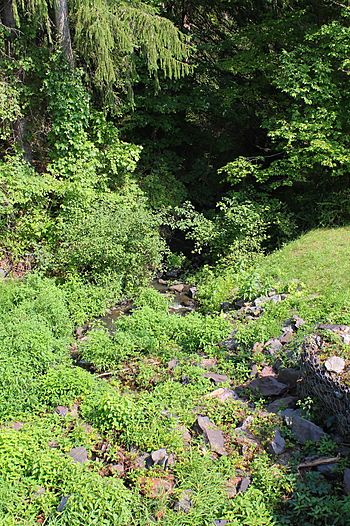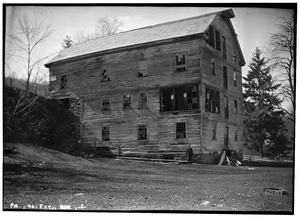Sutton Creek (Susquehanna River tributary) facts for kids
Quick facts for kids Sutton Creek |
|
|---|---|

Sutton Creek looking downstream below Lake Louise
|
|
| Physical characteristics | |
| Main source | valley in Dallas Township, Luzerne County, Pennsylvania between 1,160 and 1,180 feet (350 and 360 m) |
| River mouth | Susquehanna River in Exeter Township, Luzerne County, Pennsylvania 545 ft (166 m) 41°23′30″N 75°49′41″W / 41.39175°N 75.82819°W |
| Length | 7.6 mi (12.2 km) |
| Basin features | |
| Progression | Susquehanna River → Chesapeake Bay |
| Basin size | 11.6 sq mi (30 km2) |
| Tributaries |
|
Sutton Creek is a small river, also called a tributary, that flows into the Susquehanna River in Luzerne County, Pennsylvania. It's about 7.6 miles (12.2 km) long. The creek flows through three areas: Dallas Township, Franklin Township, and Exeter Township.
The land area that drains into Sutton Creek, called its watershed, covers about 11.6 square miles (30 km2). Sutton Creek has one main smaller stream that flows into it, named Cider Run. The creek is located a few miles upstream from the Wyoming Valley. The ground around the creek is made up of different types of soil and rocks, including alluvium (river deposits), till (rocky soil left by glaciers), and sandstone.
Many people use the land around Sutton Creek for forests and farms. Two lakes, Lake Louise and Cummings Pond, are also found in the creek's watershed. In the past, people built gristmills (for grinding grain) and sawmills (for cutting wood) along the creek. One famous mill, the Elisha Atherton Coray Mill, is even listed on the Historic American Buildings Survey. Sutton Creek's watershed is a special place for fish, known as a Coldwater Fishery and a Migratory Fishery. Many tiny water creatures, called macroinvertebrates, also live in the creek.
Contents
Creek's Journey
Sutton Creek starts in a valley in Dallas Township. It flows generally east, passing through two lakes before entering Franklin Township. After flowing through Lake Louise, the creek continues its journey, changing direction a few times.
Further downstream, it meets Cider Run, its only named tributary, which flows into it from the left side. After this, the creek enters Exeter Township. Here, it winds its way southeast and then northeast, eventually crossing Pennsylvania Route 92. Finally, Sutton Creek flows east a short distance before joining the Susquehanna River.
Creek's Helper Streams
Sutton Creek has one named tributary, which is Cider Run. Cider Run joins Sutton Creek about 3.22 miles (5.18 km) before Sutton Creek reaches the Susquehanna River. Cider Run helps drain an area of about 2.19 square miles (5.7 km2).
Land and Rocks Around the Creek
The land where Sutton Creek meets the Susquehanna River is about 545 feet (166 m) above sea level. Where the creek begins, its source, the elevation is higher, between 1,160 and 1,180 feet (350 and 360 m) above sea level.
Sutton Creek generally flows towards the east. The creek starts from a gap in a mountain. The land next to the creek and its smaller streams has narrow areas that can flood, called 100-year floodplains. Most of these floodplains in Franklin Township are along Sutton Creek and its tributaries.
All the solid rock, or bedrock, under the Sutton Creek watershed is made of sandstone. Closer to the creek's mouth, the surface soil in the valley is mostly alluvium, which is soil deposited by water. Further upstream, you can find till, which is rocky soil left by glaciers, and more bedrock. In the upper parts of the watershed, till and bedrock made of sandstone and shale are more common.
Creek's Home: The Watershed
The watershed of Sutton Creek is the entire area of land where all the rain and snowmelt eventually drain into the creek. This area is about 11.5 square miles (30 km2). The part of the watershed upstream from Cider Run is about 5.46 square miles (14.1 km2).
The main way people use the land in the Sutton Creek watershed is for forests. However, a lot of the land is also used for agriculture. Besides Lake Louise and Cummings Pond, there are also several smaller lakes in the creek's watershed.
Sometimes, Sutton Creek experiences flooding. But this flooding usually doesn't cause much damage because the areas that flood, called floodplains, are not very developed with buildings.
History of Sutton Creek
Sutton Creek was officially named and added to the Geographic Names Information System on August 2, 1979. It has also been known by other names like Sutton's Creek and Coray Creek.
In 1776, James Sutton and James Hadsall built the first gristmill and sawmill in Exeter Township right on Sutton Creek. Sadly, these mills were destroyed in a military attack in 1778. A few years later, Samuel Sutton, James's son, built a second mill there. In 1864, E.A. Coray, who owned the land then, built a third mill on the creek. The first sawmill in Franklin Township was also built on the creek in 1808 by a Mr. Munson. In the same year, Elijah Brace built the first gristmill in that township on the creek.
Over the years, several bridges have been built over Sutton Creek. Two concrete bridges for Sutton Creek Road were built in 1925. A bridge for State Route 1037 was built in 1940 near Lake Louise. In 1962, a concrete culvert bridge for State Route 1033/Bodle Road was built. A newer bridge for Pennsylvania Route 92 was built in 1999, and another concrete culvert bridge was built in 2007 for State Route 1021.
The Elisha Atherton Coray Mill, which operated on Sutton Creek, is a historic site. It is listed on the Historic American Buildings Survey.
Animals and Plants of Sutton Creek
The Sutton Creek watershed is a special place for fish. It's called a Coldwater Fishery and a Migratory Fishery, meaning it's good for fish that like cold water and for fish that travel to different places. In the past, a part of the creek, about 3.8 miles (6.1 km) long, was stocked with trout by the Pennsylvania Fish and Boat Commission. However, in 1999, this part of the creek was no longer stocked with trout.
Scientists have studied the tiny water creatures, called macroinvertebrates, that live in Sutton Creek. In August 2012, they found many different kinds of these creatures. These included different types of beetles, caddisfly larvae, crayfish, dragonfly larvae, and even leeches. They also found midge larvae, mayfly larvae, scuds, and snails. Finding a variety of these creatures shows that the creek is a healthy place for them to live.



